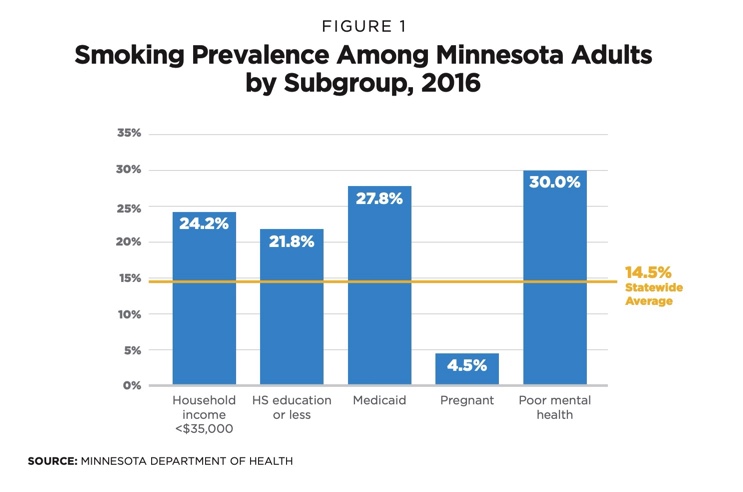Research evidence suggests St. Paul’s proposed tobacco rule will be ineffective
The city of St. Paul is set to enact one of the strictest tobacco policies in the nation. According to a report by the MPR, St. Paul city council members will vote on a new ordinance on Oct. 27 that, if enacted, will set a minimum price of $10 per pack of cigarettes and ban coupons and other discounts.
Furthermore,
Besides the price regulations, the new ordinance will also gradually cut back on the number of tobacco retail licenses in the city and mandate a half-mile separation for tobacco retailers, which could further restrict outlets.
Indeed, smoking is harmful to public health, but as a report by American Experiment shows, price hikes and restrictions are hardly the way to reduce tobacco use.
Price hikes have little impact on tobacco use
Generally speaking, regular and long-term smokers tend to be poor, low-educated or mentally ill, and therefore are not very responsive to price hikes. On top of that, nicotine is an addictive substance.
In Minnesota, for example, people with mental health issues have twice the average smoking rate. So, raising the price of cigarettes will likely have little effect on tobacco use.

On the other hand, the price floor and other restrictions will likely encourage cigarette smuggling into St. Paul and expand the black market. These are effects that have already been seen by states that have raised their tobacco taxes significantly, including Minnesota.
In 2018, Minnesota had the fifth-highest tax rate per pack of cigarettes in the country and also ranked fifth on cigarette smuggling — 36 percent of cigarettes smoked in Minnesota were smuggled in from other states. Between 2006 and 2018 Minnesota faced a 52 percent increase in cigarette smuggling. Coincidentally, the cigarette excise tax had grown by 142 percent during the same period.
Additionally, the ordinance will hurt workers and businesses that rely on tobacco sales, such as convenience stores. If prices for cigarettes go up and supply is restricted in St. Paul, tobacco users will merely flock to retailers in surrounding cities.
The rule is regressive tax on smokers
There are two reasons why tobacco taxes hurt low-income people the most:
- Tobacco taxes are a tax on consumption, and low-income individuals tend to spend
a higher proportion of their incomes on consumer products. - Low-income individuals consume cigarettes at disproportionately higher rates compared to high-income individuals and use cigarettes more frequently or with higher intensity.

Raising the starting prices for cigarettes will make it so that poor smokers spend even greater portions of their income on cigarettes. This is effectively a regressive tax on smokers.
A guide to effective tobacco policy making
Nicotine is an addictive drug, but it is not a particularly harmful drug. According to the FDA, “it is the mix of chemicals” from tobacco and tobacco smoke that “causes serious disease and death in tobacco users, including fatal lung diseases, like chronic obstructive pulmonary disease (COPD) and cancer,” and not nicotine itself.
Other tobacco products like electronic cigarettes, since they do not employ combustion, produce little to no toxins compared to smoking. Studies have estimated e-cigarettes to be as much as up to 95 percent less harmful than traditional cigarettes. Not only that, e-cigarettes have also been found to help smokers quit or help accelerate quit rates when combined with other methods like nicotine replacement therapy and behavioral support.
If St. Paul lawmakers want to reduce the harm to public health caused by tobacco, they should focus on increasing access to less harmful tobacco products like e-cigarettes. Price hikes and restrictions on cigarettes will have little to no impact in incentivizing smokers to quit.